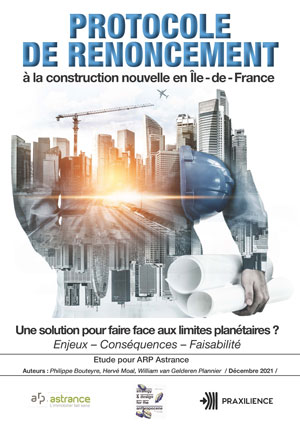Arrêter la construction neuve en Ile-de-France pour faire face aux limites planétaires : résumé de l’étude
Arrêter la construction neuve : une question motivée par l’urgence climatique
L’urgence climatique, le poids environnemental de l’immobilier, l’importance de l’effort de rénovation et de l’arbitrage à venir entre rénovation et construction sont aujourd’hui avérés. Devant ce constat, ne faudrait-il pas arrêter la construction neuve en Ile de France pour faire face aux limites planétaires ? Quels sont les impacts environnementaux de la construction neuve en Ile de France ? Son arrêt -il faisable ? Si oui, quel protocole d’arrêt faudrait-il enclencher pour prendre en compte les aspects économiques et sociaux ? L’étude répond à ces questions. Elle limite son périmètre à l’arrêt des logements, bureaux et commerces. Elle en exclue les actifs suivants : bâtiments de production, bâtiments de logistiques et équipements publiques. Cependant, elle prend en compte les 23 millions de m2 de logements, bureaux et commerces déjà engagés ou restants à construire du Grand Paris. L’étude envisage en effet l’arrêt après le Grand Paris.
L’étude de l’arrêt de la construction neuve s’appuie sur des scénarios et études qui font autorité
Cette étude croise des éléments établis par des organismes et acteurs reconnus du domaine. Pour la faisabilité, elle s’appuie sur 2 scénarios. Tous deux sont basés sur des trajectoires et hypothèses définies par l’INSEE en termes de fécondité, espérance de vie et soldes migratoires. Un premier, appelé « Business as Usual », reflète les tendances de ces dernières années. Le deuxième reflète les hypothèses basses de l’INSEE pour ces mêmes indicateurs.
L’impact environnemental de la construction neuve en Ile de France est fort
Pour commencer, l’étude révèle un fort impact environnemental de la construction neuve : majeur pour l’artificialisation et les émissions de Gaz à Effet de Serre (GES) et significatif pour la consommation de matière et la génération de déchets. Y mettre un terme diviserait par deux l’artificialisation régionale annuelle. Cela éviterait aussi d’engager annuellement 8 millions de tonnes d’émissions de GES. Cela prend en compte les produits de construction et équipements des bâtiments et les émissions dues à leur exploitation. Ce gain est équivalent à 20% des émissions annuelles régionales de GES liées à l’énergie. En outre, l’arrêt ferait gagner 8 millions de tonnes de matière par an, soit 8% des importations et extractions locales annuelles. Pour les déchets ce serait 8% de gain par an de déchets régionaux avec 3,4 millions de tonnes de déchets en moins par an. Ces impacts justifient pleinement la question du renoncement à la construction.
L’arrêt de la construction neuve est faisable pour les bureaux et commerces, plus problématique pour les logements
Partant de ce constat, l’étude questionne ensuite la faisabilité de l’arrêt. Pour les bureaux et les commerces et quel que soit le scénario, cela est faisable. Pour de nombreux sous-scénarios, il n’y a même pas besoin des commerces et bureaux neufs du Grand Paris. La réponse est plus nuancée pour les logements. Dans le scénario tendanciel et avec un faible recyclage urbain, l’arrêt n’est pas possible. Cependant avec des hypothèses basses d’évolution démographiques et un recyclage urbain plus important, c’est faisable. Dans tous les cas, la régénération urbaine peut en produire une grande partie. C’est à dire principalement par transformation de friches et par rénovations urbaines. Dans une moindre mesure par densification horizontale. De manière plus marginale par densification verticale ou par recyclage de bureaux et commerces. Cela n’est possible qu’en adaptant qualitativement la production aux capacités économiques réelles des franciliens, à l’évolution de la taille des ménages et aux besoins liés aux effets pendulaires. Quant à la question de la maison individuelle, très sensible politiquement et malgré les impacts environnementaux avérés, ce facteur n’a pas été retenu comme prépondérant.
Le flex office, le télétravail et le coût des bureaux permettent de réduire significativement les besoins en surface de bureaux
Pour les bureaux, l’étude examine divers facteurs pouvant influencer le besoin en surface. La démographie est prise en compte à travers les 2 scénarios démographiques de l’INSEE. Nous n’avons trouvé aucun signe tangible montrant que la part de la population active de bureaux pourrait évoluer. Par précaution, nous n’avons pas écarté le levier de la vacance des bureaux pour l’arrêt de la construction neuve. Nous avons cependant constaté une tendance forte de 3 phénomènes : le flex office, le télétravail et le coût des bureaux qui en se cumulant permettent de réduire de manière très conséquente la surface nécessaire de bureaux. A tel point qu’il se pose aujourd’hui le problème de surproduction et sur-offre de bureaux, amplifiée par le Grand Paris qui prévoit beaucoup de bureaux.
L’évolution du e-commerce est le facteur le plus prépondérant pour les commerces
Ensuite, concernant les commerces, outre l’évolution de la démographie en Ile de France prise en compte dans les deux scénarios, l’évolution de la vacance commerciale, de la densité commerciale (en m2 de commerces par habitant) et du tourisme, du fait de son rôle particulier dans la Région Ile de France, jouent sur le besoin en surfaces de commerces à construire. Mais c’est l’impact de l’évolution du e-commerce qui est le facteur le plus prépondérant. Il justifie à lui seul que construire de nouveaux commerces n’est pas nécessaire, ceci dans tous les scénarios.
Démographie et nombre de logements construits par ménage sont les facteurs clefs pour réduire le besoin en surface des logements
Les conclusions sur les logements reposent d’abord sur l’examen de leviers qui permettent de réduire la surface à construire. La démographie est le facteur le plus important. Mais un facteur nous a paru clef, bien plus que le tourisme, les résidences secondaires, la taille des logements, le vieillissement de la population et la vacance des logements. Il s’agit du nombre de logements construits par nouveau ménage. Aujourd’hui nous en construisons pratiquement 2 fois plus que de ménages supplémentaires. Agir sur ce ratio permettrait une réduction importante du nombre de logements à construire.
Les offres de régénération urbaine permettent aussi de réduire le besoin en construction neuve de logements
Enfin, des solutions existent pour combler les besoins en logement sans construire, donc par la régénération urbaine mentionnée plus haut : valorisation des friches, rénovation urbaine, densification horizontale et verticale, recyclage de bureaux et de commerces. L’étude a aussi identifié des offres émergentes de type co-living, habitat intergénérationnel et le foncier dit « invisible ».
Que faire des 210 000 emplois de la construction neuve en Ile de France ?
L’impact environnemental avéré et la faisabilité de l’arrêt vérifié, l’étude se penche ensuite sur la question de la faisabilité sociale et économique de cette transformation. La redirection écologique accorde une importance majeure à ces aspects. Que faire des 210 000 emplois de la construction neuve? Comment faire basculer l’économie du secteur du bâtiment de la construction à la rénovation. La première est aujourd’hui repartie à part égale entre construction et rénovation. Dans l’économie de la rénovation, nous n’aurions plus que 20% d’activité liée aux nouvelles constructions et 80% de l’activité liée la rénovation. Pour cela trois pistes principales sont identifiables. En premier lieu : la décarbonation de l’énergie liée au parc existant. Ensuite : la rénovation énergétique du parc existant. Enfin, la rénovation urbanistique des villes avec notamment les rénovations liées aux changements de modes de vie, comme la mobilité électrique.
La faisabilité politique difficile et des visions du monde freinent la démarche
Arrêter la construction neuve est difficile politiquement. Pour cause : le poids économique du secteur immobilier, son caractère diffus, le nombre d’acteurs. Sans oublier la délicate question du logement social et l’importance de la participation locale dans la politique du logement. Aussi, des visions du monde freinent la démarche de l’arrêt de la construction. Ce sont par exemple : la course à l’attractivité internationale ou l’orientation vers le neuf des métiers de l’immobilier.
Mais une dynamique bien enclenchée va dans le sens de l’arrêt
Néanmoins, une dynamique déjà enclenchée favorise la bascule vers la rénovation. La politique plus agressive de zéro artificialisation nette, les évolutions des règles d’urbanisme, un encadrement plus strict des prêts immobiliers sont autant d’outils efficaces pour maitriser et réduire la nouvelle construction. Nous pouvons tout à fait imaginer que ces tendances se poursuivent. De plus, un bon nombre de nouvelles approches telles que la mixité fonctionnelle, la réversibilité des immeubles, la remise en question de l’architecture et des architectes et les réflexions sur de nouveaux régimes de propriété vont dans le sens de l’arrêt au profit de la rénovation.
L’étude sur l’arrêt de la construction neuve met donc en lumière une tendance de fond qu’il va falloir désormais organiser
L’étude donc met en lumière des tendances de fond déjà à l’œuvre et permet de proposer des recommandations. Elle montre ainsi qu’il faut revoir le projet du Grand Paris , que le développement de surfaces de bureaux et de commerces doit faire l’objet d’une vigilance. Si des démarches de sobriété et d’urbanisme circulaire sont déjà en cours de développement et il est reste à mettre en œuvre un accompagnement des acteurs vers une économie de la rénovation et à préciser les modes de définitions des besoins sobres.
Le contexte et les auteurs de l’étude
Cette étude a été réalisée dans le cadre d’une commande de redirection écologique par Arp Astrance au Msc Design & Stratégie for the Anthropocene. Hervé Moal (Loma Management) est à l’origine de ce questionnement visionnaire. Hervé Moal (Loma Management pour le compte de Arp Astrance) et deux étudiants du master : Philippe Bouteyre (Praxilience) et William van Gelderen Plannier en sont les auteurs.
Le Msc Design & Stratégie for the Anthropocene est la première formation au monde de redirection écologique. La redirection écologique part du constat de l’Anthropocène pour faire atterrir les organisations dans les limites planétaires. Quitte a fermer certaines activités délétères ou empêcher d’autres d’advenir. Pour cela, la démarche est basée sur l’enquête et le design, permettant de se rapprocher au plus près des acteurs pour rendre la redirection faisable et sortir « par le haut (le moins bas possible) » (A.Monnin, 2021) de cette situation. Enfin, cette approche entend dépasser celles, résolument inopérantes, de développement durable, RSE et croissance verte.
La synthèse complète de l’étude est gratuitement en remplissant ce formulaire ▼



